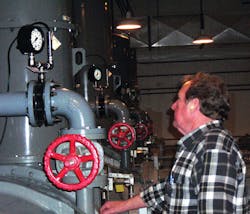Ensuring Pump Performance - Even Under Water
Baltimore County has dozens of sewerage lift stations in low lying areas throughout the county. They vary in size but are fairly consistent in design, resembling small one-story brick houses with pumps, motors and valves located in the basement. Electric controls are upstairs on the ground floor level. Although this is a nice, compact design, it was susceptible to being knocked offline during flood events when water would short circuit the pump motors.
About a decade ago, city officials began a county-wide program to upgrade every lift station to make it resistant to flood damage. The rehab consisted of replacing every conventional pump with a dry/wet submersible pump and motor. Now, even if there is a flood and the basement fills with water, the pumps continue operating without missing a beat. Some of these basements are several stories underground but the pumps operate reliably even at depths approaching 100 feet.
It became apparent, however, that the control system that monitors pump operation was a weak link. Every pump had a pressure switch on the discharge to monitor output pressure. If a rag or other foreign object became tangled in the impeller, the pressure switch would signal an alarm condition. But during flood events these controls would short out and shut the station down, leaving the submersible pumps literally dead in the water. Another problem with the pressure switches were the diaphragm seals. They were supposed to protect the switch from the raw sewage, but they would become impacted with solids, causing the switch and gauge to seize.
A two-step response provided the solution for both of these problems. The first step was to replace the conventional diaphragm seals with Onyx Isolator Rings, which drop between flanges like a wafer-style valve. The inner surface is a rubber cylinder that matches the ID of the adjacent pipe. It provides a smooth, unobstructed path for the sewage, making it absolutely impervious to clogging. Behind the rubber cylinder is an inner tube filled with silicone instrument oil that transmits pressure to the gauge and switch.
The second step was to replace the pressure switches with submersible level transmitters. Upstairs in the electrical control room, each pump has a receiver with a digital read out and alarm relay. Now, instead of just getting an alarm signal, plant operators can actually see the exact discharge pressure of each pump, enabling them to monitor pump performance on a daily basis.
In the years since the upgrade, these lift stations have repeatedly withstood flooding. The pumps and pressure controls have operated perfectly, without interruption, even while under water for weeks at a time.
Onyx Valve Company is a manufacturer ofpinch valves,check valves, andpressure sensor rings. Backed by 20 years of experience in the flow control industry, the company prides itself on the durability and longevity of its products, which are manufactured and assembled in the U.S. For more information, visit www.onyxvalve.com.
More WaterWorld Current Issue Articles
More WaterWorld Archives Issue Articles

